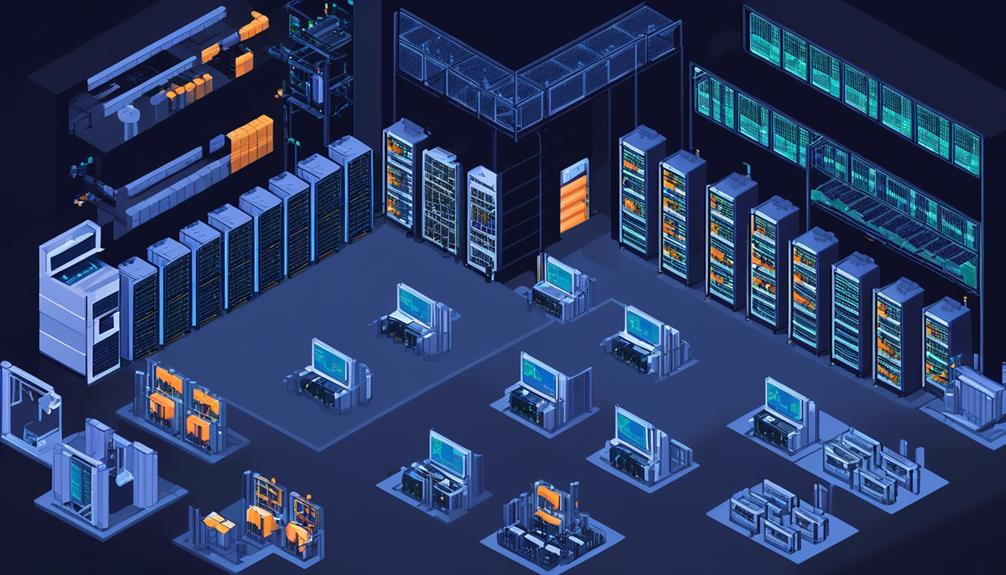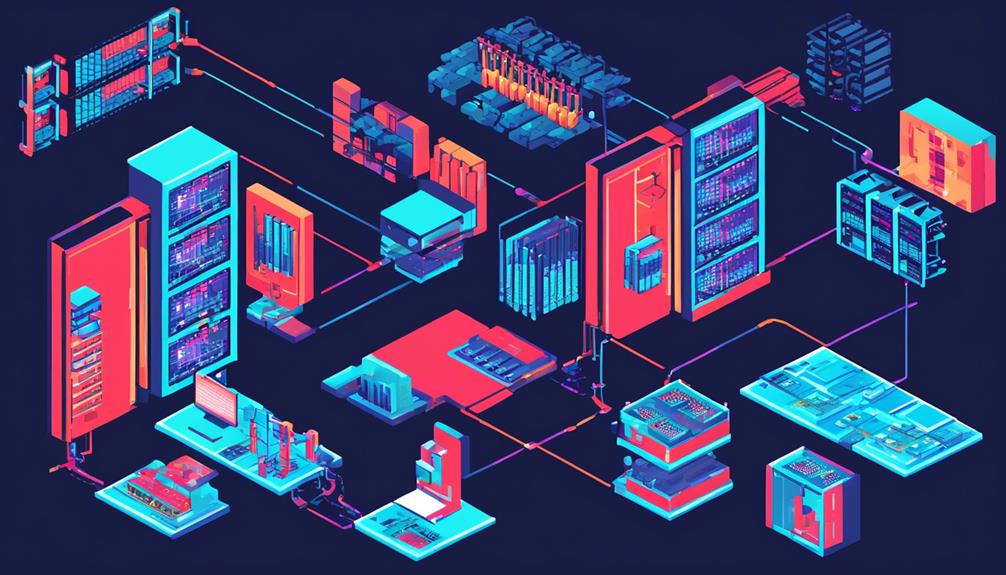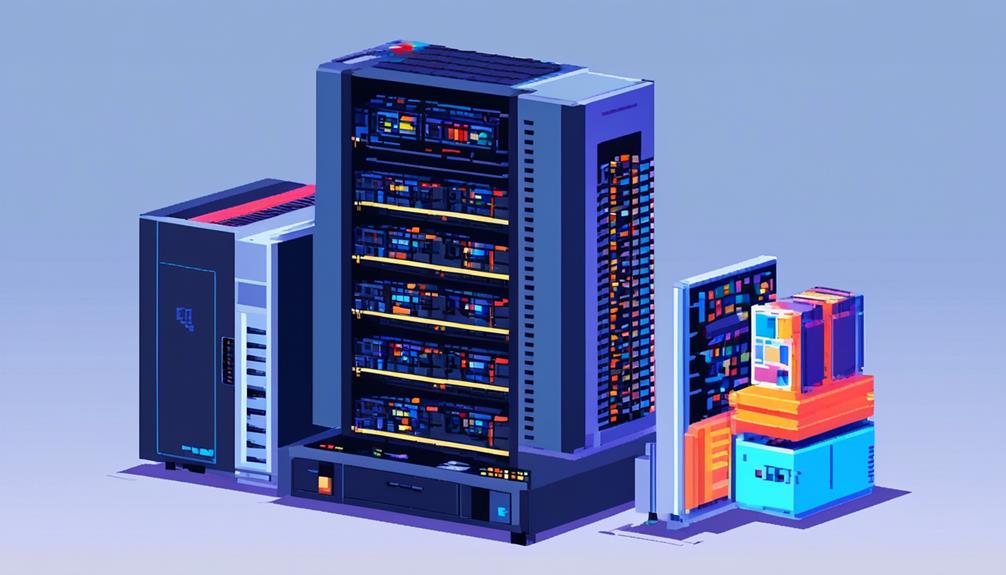In today's rapidly evolving technological landscape, edge computing has emerged as a critical component for organizations seeking to enhance their operations and meet the demands of real-time data processing.
However, ensuring high availability in edge computing environments remains a significant challenge.
The selection and implementation of suitable hardware solutions play a vital role in achieving seamless operations and minimizing downtime.
From redundant servers to failover services, organizations have various options at their disposal.
This discussion will explore the importance of high availability hardware in edge computing, key considerations for hardware selection, and the latest trends shaping the future of this rapidly evolving field.
Get ready to discover the pivotal role that high availability hardware plays in maintaining uninterrupted operations and maximizing efficiency in edge computing environments.
Key Takeaways
- High availability is crucial in edge computing to ensure uninterrupted operations and minimize downtime.
- Redundancy and fault tolerance are essential features of hardware in edge computing to enhance reliability and performance.
- Choosing rugged and reliable hardware options is important for edge computing environments with harsh conditions.
- Ongoing advancements in hardware resilience and emerging technologies like 5G and edge AI contribute to improved high availability in edge computing.
Importance of High Availability in Edge Computing

The importance of high availability in edge computing cannot be overstated, as it ensures uninterrupted operations and minimizes downtime. Edge computing refers to the practice of processing data closer to the source, rather than relying on centralized cloud data centers. This decentralized approach allows for faster processing and reduced latency, making it ideal for applications that require real-time data analysis and response, such as autonomous vehicles or industrial IoT systems.
In edge computing, high availability is crucial to ensure that services and applications remain accessible and functional at all times. Downtime can have severe consequences, leading to financial loss, compromised customer experience, and even safety issues in critical systems. Therefore, organizations must invest in redundant hardware and resilient systems to increase availability at the edge.
Advanced technologies are emerging to enhance high availability in edge computing environments. Hyperconverged systems, for example, integrate compute, storage, and virtualization into a single hardware appliance, improving efficiency and reliability. Additionally, cloud-based solutions provide scalable resources and automated failover mechanisms, ensuring continuous operations even in the event of hardware or network failures.
However, achieving high availability in edge computing can be challenging, especially for small and medium-sized businesses with limited resources and skills. They may struggle to implement redundant systems or lack the expertise to configure and maintain highly available infrastructure. To address these challenges, organizations can leverage managed service providers or adopt edge computing platforms that offer built-in high availability features, simplifying the deployment and management processes.
Key Considerations for Hardware Selection
When selecting hardware for edge computing, several key considerations must be taken into account to ensure optimal performance and high availability. These considerations include the required availability level for the edge computing environment, cost-effectiveness, hardware resiliency and reliability, emerging technologies, and strategies for small and medium-sized businesses (SMBs).
To guide decision-making, the following table presents a summary of the key considerations and their relevance to high availability hardware selection in edge computing:
| Key Consideration | Description |
|---|---|
| Required Availability Level | Evaluate the desired level of availability, expressed in the number of nines, to ensure uninterrupted operations at the edge. |
| Cost-Effectiveness | Assess the cost-effectiveness of hardware and software solutions, considering the trade-offs between investment and potential downtime. |
| Hardware Resiliency and Reliability | Examine the redundancy, failover services, and ruggedness of hardware options to mitigate the risk of downtime at the edge. |
| Emerging Technologies | Explore the potential impact of emerging technologies, like hyperconverged systems and software-defined approaches, on high availability. |
| Strategies for SMBs | Consider strategies for SMBs to achieve high availability at the edge while optimizing limited resources and ensuring reliability. |
Redundancy and Fault Tolerance in Edge Computing Hardware

Redundancy and fault tolerance play a crucial role in ensuring uninterrupted operation and minimizing downtime in edge computing hardware. In the context of high availability hardware for edge computing, redundancy refers to the presence of duplicate components or systems. These duplicates are put in place to provide backup functionality in case of failure. By having redundant clusters or failover services, edge computing hardware can continue to operate even if certain components or systems fail.
Fault tolerance, on the other hand, refers to the ability of edge computing hardware to continue functioning even when some of its components fail. This is achieved through the implementation of resilient hardware and fault-tolerant architectures. With fault tolerance mechanisms, edge computing hardware can detect failures and automatically switch to redundant components or systems, ensuring continuous operation and data integrity.
Implementing redundancy and fault tolerance strategies in edge computing hardware is essential for maintaining high availability. It not only minimizes downtime but also enhances the overall reliability and performance of the hardware. By having redundant components, edge computing hardware can handle failures without interrupting critical processes or services.
Incorporating fault tolerance mechanisms, such as redundant power supplies, network interfaces, and storage devices, further strengthens the reliability of edge computing hardware. These mechanisms ensure that even if a single component fails, the hardware can continue to function seamlessly.
Ensuring Continuous Uptime With Reliable Hardware Choices
To ensure uninterrupted operation and minimize downtime in edge computing hardware, it is imperative to make reliable hardware choices that offer high reliability and resilience. With the increasing demand for continuous availability of edge devices, organizations need to implement robust measures to ensure uninterrupted uptime.
Here are some key considerations for ensuring continuous uptime with reliable hardware choices:
- Implement backup and recovery procedures: Having a comprehensive backup and recovery strategy is crucial in minimizing the impact of hardware failures. This involves regularly backing up critical data and systems and having a well-defined recovery plan in place. By implementing automated backup processes and redundant storage systems, organizations can quickly recover from hardware failures and maintain continuous availability.
- Utilize redundant clusters with failover services: Deploying redundant clusters with failover services can significantly enhance system availability. By distributing workloads across multiple nodes and having failover mechanisms in place, organizations can ensure that in the event of a hardware failure, the workload seamlessly transitions to a backup node without disruption. This redundancy and fault tolerance approach minimizes downtime and maximizes system availability.
- Consider rugged and reliable systems: Edge computing environments often operate in harsh conditions, making it essential to choose hardware solutions that can withstand these environments. Ruggedized hardware options, designed to withstand extreme temperatures, vibrations, and other environmental factors, can significantly improve overall system availability in edge computing deployments.
Hardware Solutions for Seamless Failover and Recovery

When it comes to ensuring high availability in edge computing environments, failover mechanisms and recovery strategies are crucial considerations.
Failover mechanisms involve the automatic transfer of workload from a failed component to a backup component, minimizing downtime and maintaining continuous operation.
Recovery strategies, on the other hand, focus on restoring the system to a functional state after a failure, utilizing techniques such as data replication, backup and restore, and disaster recovery plans.
These hardware solutions for seamless failover and recovery play a critical role in achieving uninterrupted performance and minimizing the impact of failures in edge computing environments.
Failover Mechanisms
Failover mechanisms in hardware solutions play a crucial role in ensuring uninterrupted operations and seamless recovery in the event of system failures. These mechanisms are essential for high availability in edge computing environments where downtime can have significant impacts.
Here are three key points to consider regarding failover mechanisms in hardware solutions:
- Redundant hardware setups: Failover mechanisms rely on redundant hardware configurations to automatically switch to backup systems when failures occur. This minimizes downtime and ensures continuous service.
- Clustering and load balancing: Hardware solutions for failover often involve clustering and load balancing techniques to distribute workloads across multiple systems. This ensures that even if one system fails, the workload is seamlessly transferred to another system, maintaining uninterrupted service.
- Predictive maintenance and analytics: Advanced hardware solutions incorporate predictive maintenance and analytics capabilities to anticipate and mitigate potential failures before they occur. This proactive approach helps to prevent system failures and enhances the overall reliability of the failover mechanisms.
Recovery Strategies
Recovery strategies in hardware solutions for seamless failover and recovery are essential components in ensuring uninterrupted system functionality and minimizing downtime in edge computing environments. To achieve high availability, redundant clusters with failover services can be deployed. These clusters provide backup resources that can seamlessly take over in the event of a failure, ensuring continuous operations.
Implementing backup and recovery procedures is crucial to protect data and ensure system availability. Rugged and reliable hardware, such as Stratus' ztC Edge and ftServer, can significantly improve system availability by offering fault-tolerant capabilities and built-in redundancy.
Leveraging advancements in technology and deploying resilient systems are cost-effective strategies for achieving high availability in edge computing. Tailored solutions are also available for small-scale deployments, ensuring that recovery strategies are accessible to a wide range of organizations.
Scalability and Flexibility in High Availability Hardware
High availability hardware, with its inherent scalability and flexibility, plays a crucial role in enabling resilient and adaptable edge computing infrastructure.
The ability to scale resources based on demand is a key feature of high availability hardware. This scalability ensures that the system can handle increasing workloads without sacrificing performance or availability.
In addition to scalability, flexibility is another important aspect of high availability hardware. The flexibility allows the system to seamlessly adapt to changing workloads and requirements. This means that the infrastructure can easily accommodate new applications or services without significant disruptions.
To further emphasize the importance of scalability and flexibility in high availability hardware, consider the following sub-lists:
- Efficient resource utilization:
- Scalability in high availability hardware ensures that resources are efficiently utilized as the system grows.
- This allows organizations to avoid overprovisioning and unnecessary costs.
- It also enables the system to dynamically allocate resources where they are needed most, optimizing performance and availability.
- Integration of diverse technologies:
- Flexibility in high availability hardware allows for the integration of diverse technologies and components.
- This enables organizations to leverage different solutions to meet specific high availability needs.
- It also provides the flexibility to incorporate new technologies as they emerge, ensuring future-proof infrastructure.
- Resilient and adaptable infrastructure:
- The combination of scalability and flexibility in high availability hardware contributes to a resilient and adaptable edge computing infrastructure.
- This infrastructure can withstand failures and adapt to changing conditions, ensuring continuous operation and meeting evolving demands.
- It provides the foundation for edge computing, where applications and data are processed closer to the source, improving latency and reducing network traffic.
Performance Optimization in Edge Computing Hardware

Performance optimization in edge computing hardware involves maximizing computing power and efficiency to enhance data processing capabilities at the edge. Balancing computational workload distribution across edge devices is crucial for achieving optimal performance in edge computing hardware. By distributing computational tasks efficiently, the overall processing time can be reduced, leading to faster data processing and improved performance.
Utilizing specialized hardware accelerators, such as GPUs (Graphics Processing Units) or FPGAs (Field-Programmable Gate Arrays), can significantly enhance the performance of edge computing hardware. These accelerators are designed to handle specific types of computations, such as parallel processing or complex algorithms, which are common in edge computing scenarios. By offloading these tasks to specialized hardware, the overall performance of the system can be greatly improved.
Efficient data caching and storage management strategies are also essential for performance optimization in edge computing hardware. By caching frequently accessed data closer to the edge devices, the latency of data retrieval can be reduced, leading to faster processing times. Additionally, implementing intelligent storage management mechanisms can ensure that the most relevant data is stored on the edge devices, minimizing the need for data transfers between the edge and the cloud.
Furthermore, implementing intelligent load balancing and dynamic resource allocation mechanisms is key to achieving performance optimization in edge computing hardware. These mechanisms ensure that computational resources are allocated efficiently based on the current workload and the capabilities of the edge devices. By dynamically adjusting resource allocation, the system can adapt to changing workloads and optimize performance accordingly.
Monitoring and Management of High Availability Hardware
Monitoring and management of high availability hardware involves the use of hardware monitoring tools to track system uptime and performance, ensuring continuous operation.
Remote management capabilities enable administrators to monitor and control hardware remotely, facilitating efficient troubleshooting and maintenance.
Redundancy and fault-tolerance measures, such as implementing redundant clusters and failover services, help minimize downtime and ensure uninterrupted operation of critical systems.
Hardware Monitoring Tools
Hardware monitoring tools provide real-time visibility into the performance and health of critical components in high availability systems. These tools play a crucial role in ensuring the continuous operation and reliability of edge computing systems.
Here are three key advantages of using hardware monitoring tools:
- Proactive issue identification: These tools enable proactive identification of potential issues, allowing for quick resolution and minimizing downtime. Real-time alerts and historical data analysis help in identifying patterns and trends that can indicate potential failures before they occur.
- Optimal performance and reliability: Hardware monitoring tools provide insights into hardware utilization, temperature, power consumption, and component health. This information allows for optimal performance tuning and preventive maintenance, ensuring that the system operates at its best and minimizing the risk of failures.
- Predictive analytics: Monitoring and management tools often include predictive analytics capabilities. By analyzing historical data and patterns, these tools can predict potential failures or issues, allowing for proactive maintenance and reducing the risk of unexpected downtime.
Remote Management Capabilities
With the ability to remotely monitor and manage high availability hardware, organizations can ensure the continuous operation and reliability of their edge computing systems.
Remote management capabilities enable the centralized monitoring and management of high availability hardware, providing real-time visibility into hardware health, performance, and status. This allows for proactive maintenance and troubleshooting, reducing downtime and enhancing system reliability.
Remote management features, such as remote power cycling and firmware updates, can be performed without physical access to the hardware, saving time and resources. Additionally, integration with alerting systems enables immediate notification of critical issues, ensuring rapid response and resolution.
Redundancy and Fault-Tolerance
To ensure continuous uptime and reliability of high availability hardware, the implementation of redundancy and fault-tolerance mechanisms is crucial. By incorporating redundant clusters with failover services, fault tolerance can be increased, minimizing downtime in case of component failures.
Proactive monitoring plays a vital role in identifying potential faults and addressing them before they impact the system's availability. Monitoring and management tools are essential for identifying potential failures and proactively addressing them to maintain system availability.
Effective management of high availability hardware involves implementing redundant components and ensuring seamless failover mechanisms. These mechanisms can include redundant power supplies, network connections, and storage devices. Additionally, automated failover processes can be implemented to swiftly switch to backup systems in case of failure.
Future Trends in High Availability Hardware for Edge Computing
Emerging trends in high availability hardware for edge computing are shaping the future of distributed environments, emphasizing cost optimization and reliability for uninterrupted operations. As edge computing continues to gain traction, the demand for high availability solutions is increasing to ensure that critical applications and services remain accessible even in the event of hardware failures or network disruptions.
One of the key future trends in high availability hardware for edge computing is the adoption of hyperconverged systems. These systems integrate compute, storage, and networking resources into a single appliance, reducing costs and complexity while improving reliability. By eliminating the need for separate hardware components and streamlining management, hyperconverged systems offer a scalable and cost-effective solution for achieving high availability at the edge.
Another trend is the shift towards software-defined approaches. Software-defined technologies allow organizations to abstract and virtualize their infrastructure, enabling greater flexibility and agility. This approach not only simplifies management but also improves fault tolerance and availability. By decoupling hardware from software, organizations can easily replace or upgrade individual components without impacting the availability of the entire system.
Cost optimization is also a driving factor in future high availability hardware for edge computing. Two-node setups, where two physical servers work together to provide redundancy, are becoming more popular due to their cost-effectiveness. Additionally, efficient storage utilization techniques, such as data deduplication and compression, help organizations maximize their storage capacity while minimizing costs.
The lessons learned from edge computing are expected to influence future decisions in other computing environments as well. The focus on cost optimization and reliability will continue to shape the development of high availability hardware, ensuring that organizations of all sizes, including SMBs, can benefit from uninterrupted operations at the edge.
Hardware and software providers, such as Stratus, StorMagic, and VxRail, are at the forefront of these trends, offering advanced solutions to achieve high availability at the edge. Their offerings include features such as data availability, redundancy, and rapid system recovery, enabling organizations to maintain continuous operations even in challenging edge environments.
As edge computing continues to evolve, high availability hardware will play a crucial role in enabling reliable and cost-effective distributed computing solutions.
Frequently Asked Questions
What Hardware Is Used in Edge Computing?
Edge computing hardware encompasses a range of solutions designed to meet the specific requirements of edge environments. These include rugged and reliable systems capable of withstanding harsh conditions. Redundant clusters and failover services are often employed to enhance availability.
High availability hardware for edge computing can include two-node setups, software-defined storage solutions, and server clustering. Additionally, hyperconverged systems and cloud-based solutions are leveraged to improve manageability and reliability.
Emerging technologies such as containers, virtualization, and software-defined approaches on affordable commodity hardware further enhance high availability at the edge.
What Is High Availability in Cloud Computing?
High availability in cloud computing is the ability of a system or service to remain operational and accessible for a high percentage of time. It is crucial for delivering reliable and uninterrupted cloud services.
Achieving high availability in cloud computing involves ensuring system reliability, implementing backup and recovery procedures, deploying redundant clusters, and using rugged and reliable hardware.
However, there are challenges in achieving high availability, such as minimizing downtime, managing system failures, and maintaining data consistency.
High availability is essential for maximizing cloud computing benefits and providing uninterrupted service to users.
What Is High Availability in Cyber Security?
High availability in cyber security refers to the implementation of measures to mitigate the impact of cyber security threats and ensure continuous functionality and resilience of digital assets and infrastructure. It is of utmost importance to maintain high availability to prevent unauthorized access and potential disruptions.
This is achieved through redundancy, failover mechanisms, and robust recovery procedures. Distributed denial-of-service (DDoS) protection, load balancing, and disaster recovery planning are essential components of implementing high availability measures in cyber security.
Which Technology Is Used in Edge Computing?
Edge computing relies on a variety of technologies to enable its operations.
Fog computing, which extends cloud capabilities to the edge of the network, plays a crucial role in distributing computing and storage resources.
Edge devices, such as sensors and IoT devices, collect and process data locally, reducing latency and bandwidth requirements.
Edge analytics, powered by machine learning and AI algorithms, enable real-time data analysis and decision-making at the edge.
These technologies collectively enable edge computing to deliver low latency, scalability, and efficient data processing capabilities.

